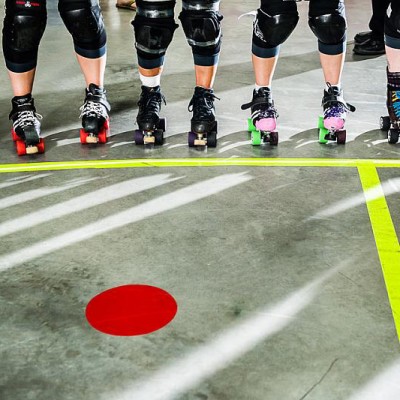
Unless you’re brand new to roller derby, you probably heard of the expression: “Leave it all on the track”. We might register this expression to giving it our all (mental, emotional, and physically) when competing. But this saying can be used to keep you in check with your focus. Have you ever been so frustrated, frazzled, or upset in a jam that you bring those feelings to the bench? I have. There have been times where I would be upset with a call or a lack of call during a jam. Even when the jam finished, I would still be bringing the emotions back to the bench.
Let’s face it, we all want to be mentally tough, especially when competing in such a physical and complex game. We train ourselves to let the distractions bounce off us and keep our focus on the game. As we head to our bench, we want to use our time to reflect,recover and adjust our game. We’re competing in real time, so we can’t perform to our best ability if we’re stuck in the future or past.
…But it happens to the best of us: we arrive to our bench with a suitcase of feelings/thoughts about that previous jam. Either we forget to check the baggage, or we just can’t let go. This Mental Muscle post is all about regaining your cool on the bench!
Being Down Doesn’t Mean You’re Out…
You might have seen this popular quote before:
“Feelings are like waves, we can’t stop them from coming in but we can choose which ones to surf”.
As an athlete you can experience emotions that might be pleasant, unpleasant, helpful, or even harmful to your performance. If you choose to dwell on the emotions that will hinder your performance, then your performance will suffer. It comes down to how we choose to react to a situation. More importantly, what feelings we choose to feed. Just as with avoiding the penalty spiral, having a specific routine in place can help with refocusing and controlling your emotions.
5 Steps to Regaining Control on the Bench
The next time you feel that you’ve brought unwanted emotions with you to the bench, try applying these easy 5 steps to regain focus and control.
Step 1 – Acknowledge Your Emotions
Regardless of what type of emotion you’re feeling, you need be aware how that specific emotion impacts your body, mind, and actions. As you’re sitting on the bench, if you realize that your emotions are having a negative impact, you need to acknowledge it. Realize that you’re surfing the wrong wave. You can acknowledge by using a Physical Cue (clap hands, snap fingers, nod head) and/or a Verbal Cue (“I’m red”, “Wrong wave”, “Time to switch”).
That being said, sometimes you’re not the one that realizes it. Sometimes your coaches or teammates might tell you that you need to relax, get focus, let it go, etc. Listen to their advice. If a teammate is telling you that you need to take a breather, instead of being on the defense it’s better to take that as a sign to reflect on and acknowledge your emotions.
Step 2 – Talk to Someone
Let your coach, line caller, or a teammate know that you need to take a moment to reset your mindset. You already have emotions that followed you back to the bench; you don’t need to add more conflict because your teammates or coaches are speculating on your mood or state of mind. There is no shame in taking a moment. By telling someone on the bench, it could also hold you accountable for making the needed changes.
Step 3 – Move to the End of the Bench
If you’re like me, you have a go-to spot on the bench. For myself, this is the spot that my brain associates with “reflection and recovery”. By moving to the end of the bench, I am creating a new link to my brain. My brain will associate sitting at the end of the bench as ‘it’s time to regroup and reset’.
Another reason to move to the end of the bench is that usually when an athlete comes off the track they tend to sit next to their pack-mates so they can discuss and plan strategy. If you need to take a moment to control your emotions, sitting next to your teammates can be distracting to both you and to them. One of my biggest pet peeves as a roller derby athlete was sitting near those who lost their cool. I could feel their negativity and reckless behaviours. I can remember games where one person’s meltdown affected the entire bench. Don’t be that teammate: take a seat at the end for just one jam!
Step 4 – Relax and Readjust
Now that you’re at the end of the bench for some ‘me time,’ it’s time to relax and readjust your mindset. A majority of the time when athletes get into this position it’s because they’re over-aroused. High arousal levels can lead to athletes feeling out of control. By using relaxation techniques, you can remove the unwanted tension that is building up in your bodies. I usually suggest to athletes to take 1 to 2 jams off to regroup. Obviously this depends on the length of the jams themselves, so you might need to adjust depending on your needs.
What you choose to do in order to relax is up to you. Here are some common techniques that are easy to use on the bench:
1. Listening to Music
Bring an iPod to the bench with you in preparation that you might need it. This is especially true if music is your quick fix for getting in control of your emotions. Remember that you want to find a genre of music, or specific songs, that make you feel relaxed, calm, and centered.
2. Relaxing Breathing Techniques
These can decrease your heart rate and energy levels. Slow and controlled breathing also increases oxygen to the blood and relaxes your muscles. Get in a comfortable position. Inhale through your nose and slowly fill your lungs with air, and then slowly exhale through your mouth. With every breath you exhale, you are feeling more relaxed and in control of your own body.
3. Relaxing Imagery
Picture an image or place yourself in an environment that induces relaxing feelings. As you see your mental image, you want to relax and melt into your chair.
4. Verbal Cues
Just as images can be used to relax your mind and body, verbal cues can be used to remind yourself to breathe or relax.
Step 5- Focus Back on the Game
Now that you feel calm and in control of your feelings, thoughts, and actions, it’s time to refocus back into the game and bench environment. The feelings that you had before are gone, so it’s time to think about the present moment. Bottom line, as soon as you leave the end of the bench, you are back into game mode.
Some tips to keep in mind:
- Check back in with your coach or teammate to let them know that you’re in the right mindset. If you created a goal for yourself, share it with them.
- Sit back with your pack-mates and talk about the game / what your team needs to do! Make that link that sitting with your teammates means preparing to be the best you can be on the track.
Just like any refocusing plan, practice will make it more of a routine response. If you need to take a break in a practice scrimmage or a regular practice follow the same steps: Acknowledge emotions, Talk about it, Move Away, Relax, Refocus.
– – – – –
What techniques have you been using so far to reset after a tough jam, or when your emotions get the best of you? Talk about it in the comments below so we can all learn from each other!
-Jess Bandit

 Prehab! Feet and Ankles
Prehab! Feet and Ankles  Fresh Meat – You Got This!
Fresh Meat – You Got This!  Go From Benchwarmer to MVP with the 1% Secret
Go From Benchwarmer to MVP with the 1% Secret  How to Improve at Derby’s 27 Laps Test
How to Improve at Derby’s 27 Laps Test  PreHab: How to Reduce Concussions
PreHab: How to Reduce Concussions